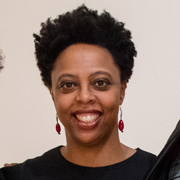 Emma Amos, (March 16, 1937 — May 20, 2020), "Equals," 1992. Acrylic on linen canvas with African fabric borders 76 X 82 inches Private Collection Doree Friedman, CA.
Emma Amos, (March 16, 1937 — May 20, 2020), "Equals," 1992. Acrylic on linen canvas with African fabric borders 76 X 82 inches Private Collection Doree Friedman, CA.
Remembering Emma Amos
In the wake of artist Emma Amos' passing, Shawnya Harris, our Larry D. and Brenda A. Thompson Curator of African American and African Diasporic Art, shares an excerpt from her upcoming catalog which will accompany the Georgia Museum of Art's upcoming Emma Amos: Color Odessy exhibition.
I met Emma Amos around 2009 while I still worked in North Carolina. I had been thinking about her work for a while, often seeing reproductions in books such as those by bell hooks and Sharon Patton’s classic survey text, African American Art since my undergraduate days at Yale. I did not hear much talk about her except an occasional inclusion in a group exhibition.
At the time, she was affiliated with Flomenhaft Gallery and I gave them a call to ask if the artist was open to studio visits and if she minded being contacted. They eagerly contacted her for me and encouraged me to both visit the gallery and to see the artist herself.
When I talked to Emma, it was like speaking to an old friend. She identified with me working and going to school and was surprised that she was “remembered.” She encouraged me to visit the studio and hang out in New York, offering a place to stay if needed. Correction: She insisted I stay with her instead of a hotel. Firm, yet sweet in her invitation, I knew instantly that she had indeed not lost her southern roots.
In that first of many visits in the early millennium, I beheld Amos as a passionate artist, full of life and ideas. I vividly recall her standing at the top of the stairs of her Bond Street apartment, saying “Well, get on up here, girl!” when I arrived or welcoming me from a one floor elevator ride directly to her studio.
Her work was everywhere. The colored fabrics hit my eyes instantly; works in progress lay on her large work table. Fragments of old Guerilla Girls posters were prominently displayed on the back wall. Rolls of completed work in an upper loft prompted much curiosity. Bookshelves in adjoining rooms were surmounted by early works or smaller works by her favorite artists. And of course the iconic works bordered in African textiles, open to a particular masterpiece, hung silently, waiting for interest and inspection like a page in book. I instantly fell in love with visiting the Bond Street studio loft.
As studio assistants Kate and Natalia, pulled out work, Amos loved to talk about it and would gleefully say, “Yeesss,” when she felt that you understood it. She loved talking about visiting Elizabeth in Mexico. She had recently seen bell, and Camille. She missed Norman and Vivian. And an art historian “who looked like a model” was writing a book about her and I should get to know her too. Of course, we would be going to eat at NoHo Star around the corner and do some people watching. Bobby was a good husband; Nick and his family recently visited; India was calling. She made you feel included in her life as both and artist and a person; you were a part of the family.
The exhibition that I had planned in North Carolina never happened, but in later years I knew that I would revisit it. My first email I sent from the Georgia Museum of Art: contacting Emma’s studio to let them know that I would be back to talk about an exhibition. I learned she had new gallery representation through Ryan Lee, which was great, but things had changed by then. Her developing works were simpler collage works, not the larger, complex ones I was accustomed to seeing. Her memory was not as vivid and she had good days and bad days. When I visited her in fall 2015, she did not recall me exactly, but when I said “Georgia,” her eyes lit up. “I wish I could go back to Georgia again,” she said. Although many of us involved had hoped, deep down we knew, that may never happen.
So it is bittersweet that as I write my essay for her first catalog in 27 years, that Emma Amos has departed from this world. However, I am comforted in knowing that the spirit of her work continues to hold currency. In the midst of the coronavirus pandemic, I immediately think of her classic Falling Series, characterized by the uncertainty of the future and the trauma of the present. Racism, sexism, xenophobia and global economic turmoil are familiar societal ills given form, color and texture through Amos’s work. They are with us but to her credit, Emma Amos’s odyssey as an artist tackling these and other themes is as well.
